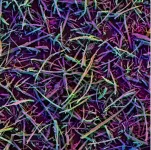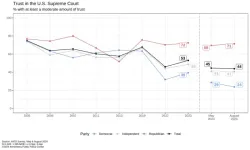(Press-News.org) Researchers at NYU Langone Health were awarded $1.6 million from the National Institutes of Health (NIH) to investigate changes in the eye that may indicate early signs of Alzheimer’s disease and Parkinson’s disease.
The award, OT2OD038130, recognizes the eye as a part of the brain and its role as a window into cognitive and visual health. After the initial $1.6 million award, the grant may renew an additional two years, for a total of $4.8 million as part of the NIH Common Fund Venture Program’s new Oculomics Initiative. Oculomics is a relatively new term to describe the integrative use of technology and ocular imaging to identify retinal biomarkers of systemic disease.
The study at NYU Langone Health will apply a novel eye-imaging technology, visible-light optical coherence tomography (OCT), to detect biomarkers of neurodegenerative disease, including Alzheimer’s disease and Parkinson’s disease. Vivek J. Srinivasan, PhD, associate professor in the Departments of Ophthalmology and Radiology at NYU Grossman School of Medicine and a member of the Tech4Health Institute; and Laura J. Balcer, MD, MSCE, vice chair of the Department of Neurology and professor in the Departments of Neurology, Ophthalmology, and Population Health, will be the principal investigators.
“The goal is to find signatures of neurological disease by looking into the eye, which is an easily accessible window to the brain,” said Dr. Srinivasan. “Using visible-light OCT, we are able to capture high-resolution images of the retina to potentially detect the early and progressive changes that are associated with neurological conditions.”
Visible-light OCT can capture micrometer-level images of the retina to better detect subtle structural changes in neurodegeneration, according to Dr. Srinivasan. Traditional OCT uses near-infrared light, which can only capture at a resolution of 3 micrometers at best. Visible-light OCT also enables molecular sensitivity in the retina. The emerging technology, advanced by Dr. Srinivasan at NYU Langone, will be used to map the retina among patients referred by cognitive neurologists and clinicians in the Fresco Institute for Parkinson’s and Movement Disorders, the Alzheimer’s Disease Research Center, and the Pearl I. Barlow Center for Memory Evaluation and Treatment.
“We’re investigating important aspects of neuro-ophthalmology in this study and trying to answer three big questions,” said Dr. Balcer. “How can we distinguish eyes of those with neurological disease compared to those of disease-free individuals of similar age using visible-light OCT? How can we identify these conditions by looking at retinal layers? And how can we monitor the effects of therapies?”
Dr. Balcer, a neuro-ophthalmologist, is the career-long colleague of Steven L. Galetta, MD, the Philip K. Moskowitz, MD, Professor of Neurology and the chair of the Department of Neurology. Dr. Balcer is renowned for her team’s research linking changes to the eye as indicators of such neurological conditions as multiple sclerosis and concussion. She says that this study could lead to a breakthrough in adding vision exams to assess and potentially even diagnose Alzheimer’s or Parkinson’s diseases at early stages. Earlier detection could mean interventions are introduced sooner, or that patients can be enrolled sooner into clinical trials to help develop new therapies.
“This support by the NIH is further recognition of the important role that eye and vision play in not only how we experience our world, but also as a window into our cognitive and overall health,” said Kathryn A. Colby, MD, PhD, the Elisabeth J. Cohen, MD, Professor of Ophthalmology and chair of the Department of Ophthalmology. “Dr. Srinivasan and Dr. Balcer are leaders in advancing the emerging science of oculomics, and it’s thrilling to see this important work progress so that we might one day soon be able to slow the progression of these debilitating diseases.”
Other NYU Grossman School of Medicine investigators involved in the project include Kevin Chuen Wing C. Chan, PhD; Un J. Kang, MD; Rachel Kenney, PhD; Arjun V. Masurkar, MD, PhD; Yasha S. Modi, MD; Giulietta M. Riboldi, MD, PhD; Shy Shoham, PhD; and Einar M. Sigurdsson, PhD.
Learn more about NIH Common Fund Venture Program’s Oculomics Initiative.
END
NYU Langone awarded $1.6 million to investigate Alzheimer’s & Parkinson’s progression through the eye
2024-10-02
ELSE PRESS RELEASES FROM THIS DATE:
Missing link found in gamma emission phenomena from thunderclouds
2024-10-02
Groundbreaking Discoveries in Gamma-Ray Emissions from Thunderstorms
In the recent edition of Nature, groundbreaking results about the gamma-ray emissions produced during thunderstorms are presented. Overall, these findings reveal that gamma-ray emission from thunderclouds is much more complex, diverse, and dynamic than previously thought. Understanding these phenomena is crucial to uncovering the secrets of lightning.
Flickering Gamma-Ray Flashes: A New Discovery
Entitled “Flickering Gamma-Ray Flashes, the Missing Link between Gamma Glows and TGFs,” the paper by Østgaard et al. [2024] reports unique observations of a new phenomenon called Flickering Gamma-Ray ...
Social media users’ actions, rather than biased policies, could drive differences in platform enforcement
2024-10-02
A new paper, “Differences in misinformation sharing can lead to politically asymmetric sanctions,” published today in Nature suggests that the higher quantity of social media policy enforcement (such as account suspensions) for conservative users could be explained by the higher quantity of misinformation shared by those conservative users — and so does not constitute evidence of inherent biases in the policies from social media companies or in the definition of what constitutes misinformation.
Written by ...
How a bacterium becomes a permanent resident in a fungus
2024-10-02
Endosymbiosis is a fascinating biological phenomenon in which an organism lives inside another. Such an unusual relationship is often beneficial for both parties. Even in our bodies, we find remnants of such cohabitation: mitochondria, the powerhouses of our cells, evolved from an ancient endosymbiosis. Long ago, bacteria entered other cells and stayed. This coexistence laid the foundation for mitochondria and thus the cells of plants, animals, and fungi.
What is still poorly understood, however, is how an endosymbiosis as a lifestyle actually arises. A bacterium that more or less accidentally ...
Study: For long COVID, lithium aspartate at low doses is ineffective, but higher doses may be promising
2024-10-02
BUFFALO, N.Y. — A small University at Buffalo clinical trial has found that at low doses, lithium aspartate is ineffective in treating the fatigue and brain fog that is often a persistent feature of long COVID; however, a supplemental dose-finding study found some evidence that higher doses may be effective.
Published in JAMA Network Open on Oct. 2, the study was led by Thomas J. Guttuso, Jr., MD, professor of neurology in the Jacobs School of Medicine and Biomedical Sciences at UB and a physician with UBMD Neurology.
“It’s a negative study with a positive twist,” Guttuso concludes.
Because ...
Online insomnia treatment can help caregivers get much-needed rest, study suggests
2024-10-02
Providing care for a family member with a disabling illness can be a demanding job that leaves many people unable to sleep, but an online insomnia treatment developed at the University of Virginia School of Medicine can help, new research shows.
Not only did the SHUTi (Sleep Healthy Using the Internet) sleep intervention help caregivers get better rest, it most benefited those shouldering the greatest responsibilities in caring for their loved ones, the researchers found.
The results suggest the online format of the program ...
Attivare licenses Wyss Institute’s immune-modulating biomaterial technology to advance immunotherapies
2024-10-02
Attivare licenses Wyss Institute’s immune-modulating biomaterial technology to advance immunotherapies
The company is developing the biomaterial-based technology to develop novel therapies able to program anti-cancer immunity and prevent infectious diseases
By Benjamin Boettner
(BOSTON) — Today, the Wyss Institute for Biologically Inspired Engineering at Harvard University and Attivare Therapeutics Inc. announced that Attivare has licensed a portfolio of immune-modulating biomaterial technologies from Harvard University that was created at the ...
Regenstrief, Fairbanks researcher among 25 fellows to be inducted into American College of Medical Informatics
2024-10-02
The American College of Medical Informatics (ACMI) has announced that Chris Harle, PhD, of the Indiana University Richard M. Fairbanks School of Public Health and the Regenstrief Institute will be inducted as one of 25 new fellows on November 10 in San Francisco, CA, at ceremonies during the American Medical Informatics Association (AMIA) 2024 Annual Symposium.
ACMI is a college of elected fellows who have made significant and sustained contributions to the field of biomedical informatics. Individuals who have achieved national recognition in the field and are committed to advancing ...
Ontario Institute for Cancer Research funding aims to speed the development of new drugs for some of the most common cancers
2024-10-02
October 2, 2024, TORONTO – The Ontario Institute for Cancer Research (OICR) continues to support Ontario drug discovery research by funding high-quality investigations of new therapies for some of the most prevalent pediatric and adult cancers. These projects are tackling substantial challenges in cancer by increasing the effectiveness and availability of immunotherapies, making cancer more vulnerable to chemotherapy and developing a new drug for one of the deadliest forms of childhood brain cancer.
OICR’s Cancer Therapeutics Innovation Pipeline (CTIP) initiative is supporting three research teams ...
Trust in US Supreme Court continues to sink
2024-10-02
PHILADELPHIA – Driven by political partisanship, public trust in the U.S. Supreme Court has continued a downward slide since the court’s 2022 Dobbs decision overturning the Roe v. Wade ruling that established a constitutional right to abortion, according to a new survey by the Annenberg Public Policy Center (APPC) of the University of Pennsylvania.
More than half of Americans (56%) now disapprove of the Supreme Court, saying they trust it either “a little” or “not at all” to act in the best interest ...
Rice’s Biotech Launch Pad to lead commercialization of bioelectrical implant treatment for obesity, type 2 diabetes
2024-10-02
Rice University is part of a multiuniversity research team that has secured an award of up to $34.9 million from the Advanced Research Projects Agency for Health (ARPA-H) to accelerate the development of a bioelectronic implant designed to improve adherence for obesity and type 2 diabetes (T2D) treatment while reducing development and manufacturing costs.
Rice University’s Biotech Launch Pad will lead the commercialization effort for “Rx On-site Generation Using Electronics” (ROGUE), a self-contained, durable implantable device that houses cells engineered ...





